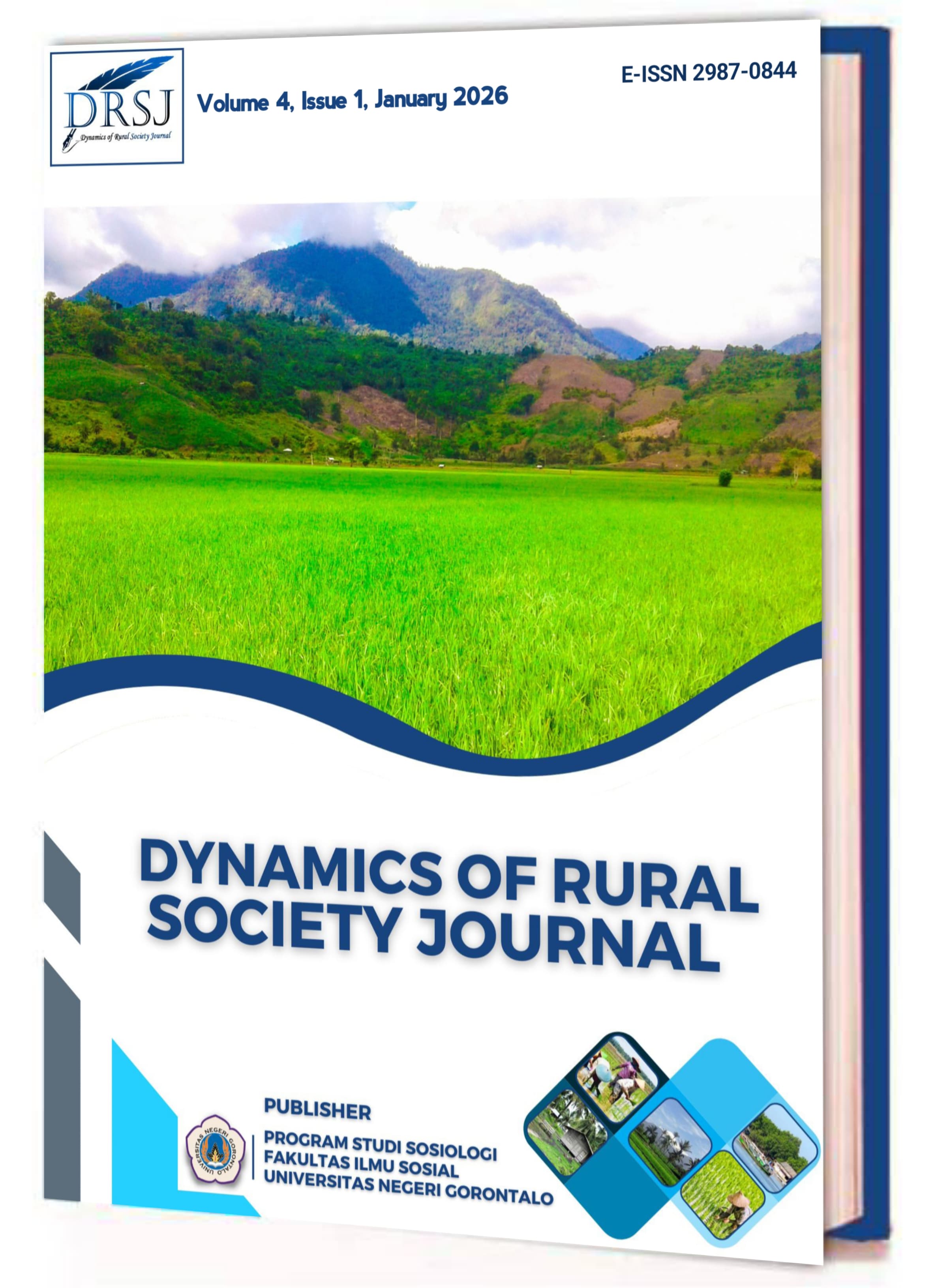Identifying the causes of food insecurity and household coping behaviors in Southern Niger
DOI:
https://doi.org/10.37905/drsj.v4i1.92Keywords:
Copying Strategies, Food Insecurity, Household, NigerAbstract
Despite significant efforts by the Nigerien government and several international organizations, such as the World Food Program (WFP) and various non-governmental organizations (NGOs), food insecurity continues to affect a substantial portion of the Nigerien population. This study aims to identify the causes of food insecurity and examine the coping strategies adopted by households to mitigate hunger. A structured survey was conducted in 15 villages in the Kollo region of Niger, where household heads were randomly selected for interviews. A total of 500 households participated. Using the Multinomial Probit model, the study explores factors influencing households' choices of coping strategies, hypothesizing that these behaviors are shaped by socio-economic and demographic characteristics. The results reveal that food insecurity is driven by factors such as drought, soil infertility, lack of agricultural inputs, crop pests and diseases, and limited financial resources. In response, households employ strategies such as selling livestock, migrating in search of better opportunities, consuming less preferred foods, and resorting to unusual borrowing. The study concludes that enhancing the sustainability of agricultural production through the promotion of climate-smart agricultural technologies is crucial for improving food security and strengthening household resilience to future challenges.
Downloads
References
Corbett, J. (1988). Famine and household coping strategies. World Development, 16(9), 1099–1112. https://doi.org/10.1016/0305-750X(88)90103-9
Cornia, G. A., & Deotti, L. (2008). Niger’s 2005 food crisis: Extent, causes and nutritional impact (Working Paper No. EUDN/WP 2008–15). European Commission. https://www.eudnet.net/download/wp/EUDN2008_15.pdf
Devereux, S. (2009). Why does famine persist in Africa? Food Security, 1, 25–35. https://doi.org/10.1007/s12571-009-0005-8
Devereux, S. (1993). Goats before ploughs: Dilemmas of household response sequencing during food shortages. IDS Bulletin, 24(2), 52–59. https://doi.org/10.1111/j.1759-5436.1993.mp24002007.x
Food and Agriculture Organization. (2011). The state of food insecurity in the world 2011 (Working Paper). FAO. http://www.fao.org/publications/sofi/en/
Food and Agriculture Organization. (2008). The state of food insecurity in the world 2008: High food prices and food security – Threats and opportunities (Working Paper). FAO. http://www.fao.org/docrep/011/i0291e/i0291e00.htm
Food and Agriculture Organization. (2021). Climate change response strategies for agriculture: Challenges and opportunities for the 21st century. FAO. https://www.fao.org/fileadmin/templates/em2009/docs/World_Bank__2008c_.pdf
Food and Agriculture Organization. (2022). Youth in agriculture and food systems transformation in Africa. FAO.
Food and Agriculture Organization. (2024). Regional report on food and nutrition security for West Africa and the Sahel 2024: In brief. FAO.
Greene, W. H. (2007). Econometric analysis (7th ed.). Prentice Hall.
International Monetary Fund. (2022). Economic effects of climate change and food insecurity in Niger. https://www.imf.org/en/Publications/Departmental-Papers-Policy-Papers/Issues/2022/09/13/Climate-Change-and-Chronic-Food-Insecurity-in-Sub-Saharan-Africa-522211
Kafle, K., & Balasubramanya, S. (2022). Reducing food insecurity through equitable investments in irrigation: The case of Niger. Journal of Agricultural and Applied Economics, 1, 494–515. https://doi.org/10.1002/jaa2.40
Koné, M., & Touré, O. (2006). Évaluation du dispositif de prévention et de gestion des crises alimentaires du Niger durant la crise de 2004–2005: Enquêtes sur les conditions de vie des ménages dans les régions de Maradi et Zinder. IRAM.
Maxwell, D. (1996). Measuring food insecurity: The frequency and severity of coping strategies. Food Policy, 21(3), 291–303. https://doi.org/10.1016/0306-9192(96)00009-7
Maxwell, D. (1995). Measuring food insecurity: The frequency and severity of “coping strategies” (FCND Discussion Paper No. 8). International Food Policy Research Institute.
Maxwell, D., Ahiadeke, C., Levin, C., Armar Vo Duc, H. (2023-Klemesu, M., Zakariah, S., & Lamptey, G. (1999). Alternative food security indicators: Revisiting the frequency and severity of ‘coping strategies’. Food Policy, 24(4), 411–429. https://doi.org/10.1016/S0306-9192(99)00031-4
Maxwell, D., Caldwell, R., & Langworthy, M. (2008). Measuring food insecurity: Can an indicator based on localized coping behaviors be used to compare across contexts? Food Policy, 33(6), 533-540. https://doi.org/10.1016/j.foodpol.2008.04.004
Maxwell, D., Watkins, B., Wheeler, R., & Collins, G. (2003). The Coping Strategies Index: A tool for rapid measurement of household food security and impact of food aid programs in humanitarian emergencies. CARE and World Food Programme.
Mjonono, M., Ngiidi, M., & Hendricks, S. L. (2009). Investigating household food insecurity coping strategies and the impact of crop production on food security using the Coping Strategy Index (CSI). 17th International Farm Management Congress. Bloomington/Normal, Illinois, USA.
Molua, E. L. (2012). Gendered response and risk-coping capacity to climate variability for sustained food security in Northern Cameroon. International Journal of Climate Strategies and Management, 4(3), 277-307. https://doi.org/10.1108/17568691211238948
Vo, D. H. (2023). Does domestic migration adversely affect food security? Evidence from Vietnam. Heliyon, 9, e13789. https://doi.org/10.1016/j.heliyon.2023.e13789
World Bank Group. (2022). Gender differences in household coping strategies for COVID-19 in Kenya (Policy Research Working Paper No. 9959). https://documents1.worldbank.org/curated/en/861451646668280669/pdf/Gender-Differences-in-Household-Coping-Strategies-for-COVID-19-in-Kenya.pdf
World Food Programme. (2025). FAO and WFP early warning report reveals worsening hunger in 13 hotspots: Five with immediate risk of starvation. https://www.wfp.org/news/fao-and-wfp-early-warning-report-reveals-worsening-hunger-13-hotspots-five-immediate-risk
World Food Programme. (2023). Comprehensive Food Security and Vulnerability Analysis (CFSVA) – Niger.
Zakari, S. (2014). Factors affecting Niger food security: An analysis at national and household levels [Doctoral dissertation, Huazhong Agricultural University]. College of Economics and Management, Wuhan, China.
Downloads
Published
How to Cite
Issue
Section
License
Copyright (c) 2025 Seydou Zakari

This work is licensed under a Creative Commons Attribution-NonCommercial 4.0 International License.


.png)







